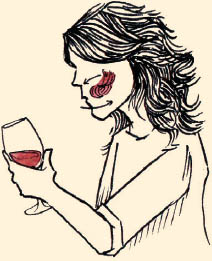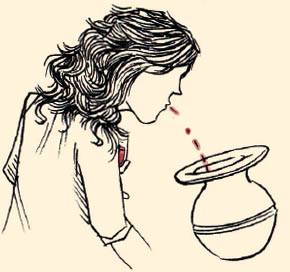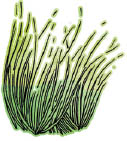TASTE
Now the really fun part—putting the wine in your mouth. Learning to communicate what you taste is as challenging as talking about what you smell, but practice makes progress. The more wines you’ve tasted and have under your belt as a reference point, the better you’ll get at this too.
There’s not one singular, standard tasting method that all wine professionals use when evaluating wine, but the following are a few key components on everyone’s mind.
Acidity: How tart, or acidic, is the wine?
Balance: Are all the flavors of the wine harmonious?
Complexity: Is it interesting? Or one-dimensional?
Finish: What is the finale of the wine like? Is it short or long? Elegant or harsh? Does it leave you wanting more?
Tannin: Is there mouth-drying tannin in the wine? If so, is it pronounced or subtle?
Typicity: Does the wine taste like the grape and/or the region it comes from?
v
Did You Know? A supermarket chain in England insured the tongue of its chief [wine] buyer for a reported 17.3 million dollars. / Wine Spectator
WINE TALK
Just like with the aroma wheel, having a handy vocabulary list of tastes helps you convey how you feel about a wine’s personality. Here are some of the most commonly used descriptors and what the heck they actually mean.
acidic. A wine with high, but balanced, acidity tastes tart and crisp—with echoes of lemon or grapefruit in white wines and cranberry in reds. Acidic can have a negative connotation, if the acid seems too harsh.
angular. A wine that is tough and harsh-feeling in your mouth. The opposite of round and supple. A bed of nails vs. a pillow-top mattress. Crunchy vs. creamy. Young, tannic wines can sometimes be described as angular—they haven’t had the benefit of time to soften all the rough edges.
appley. A wine that tastes and smells like apples.
approachable. A wine that seems friendly and easy to drink.
aromatic. The wine has obvious and pleasing smells.
austere. The wine is lean and lithe, and ripe fruit is not the main focus. Graceful and elegant, but somewhat closed. The subtle, lean and mean wines of Chablis, France, are often called austere.
baked. The wine tastes like cooked or reduced fruit. It could be a sign of a very hot vintage, when the grapes came in overripe, literally baked from the sun, or of heat damage to the bottle sometime after vinification.
balanced. All the aromas and flavors of the wine are harmonious; nothing sticks out.
beefy. Similar to big and brawny. A bold, manly wine.
big. A full-bodied, mouth-filling wine with a lot of flavor and alcohol.
bitter. Most likely a wine tastes bitter due to high tannin levels.
brawny. A weighty, substantial wine with an unpolished edge.
buttery. The wine has the flavor of butter or cream; apparent most often in some chardonnays.
chewy. The wine has a thick texture; it almost feels as though you could chew it.
cloying. The wine is offensively sweet and syrupy, and lacks acidity to balance the sugar.
complex. The wine is interesting; it has a lot going on. There are many aromas and flavors to talk about, and it keeps changing.
creamy. Implies a lush, rich, cream-like texture; the opposite of thin and tart.
deep/depth. Similar to complex. Wine with depth has layers of flavor.
delicate. A wine with mild manners and fine, focused flavor; the opposite of brawny, beefy, and big.
dry. A word used often to describe wine. A red wine can taste dry because it has a lot of tannin (like the kind of dry you taste in unsweetened iced tea); it can also taste dry because it has an absence of ripe fruit flavor, or sugar.
earthy. The wine smells or tastes like earth, manifested in aromas and flavors including barnyard (or farm animal smell), chalk, dirt, dust, forest floor, granite, gravel, limestone, meat, moss, mushrooms, peat, and salt.
fat. A derogatory term meaning that a wine lacks acidity. It’s all flesh, with no bone or spine.
flat. A dead-tasting wine. It lacks life and vibrancy, most often because it lacks acidity.
floral. A wine that smells like flowers. Common flowers include rose (especially in gewürztraminer, pinot noir, and Barolo), gardenia (in viognier), and citrus blossom (in chardonnay).
fruit-forward. Fruit flavors dominate the smell and taste; less earthy.
fruity. Much the same as fruit-forward, with a connotation of a very ripe fruit flavor, bordering on slightly sweet.
full-bodied. A wine that has significant weight and viscosity. Full-bodied wines feel thick, as opposed to light-bodied wines, which feel thinner. Body is directly related to alcohol; more alcohol equals more body.
funky. Some might prefer a little earthy funk in their wine, but for the most part this is a negative descriptor of wines that smell rotten. (See “Awful Aromas,” page 70, to find out what this can tell you about your wine.)
grassy. A wine that smells or tastes like freshly cut grass.
green. A wine that tastes underripe. Cabernet sauvignon grapes that don’t fully mature can taste green—like green bell peppers or even jalapeños.
hearty. A substantial wine with lots of flavor, power, and intensity.
herbal. A wine that tastes like herbs; basil, mint, sage, rosemary, lavender, chamomile, and white or black pepper flavors are all commonly found in wine.
hot. A negative descriptor. It means that the alcohol is out of balance; there’s so much that it’s the dominant flavor in the wine.
inky. A wine with deep, saturated color. Typically it will look and feel thick, like ink.
jammy. A wine that tastes like fruit jam.
lean. A wine that is light and muscular, as opposed to big and brawny. Think ballet dancer as opposed to sumo wrestler; sushi as opposed to pot roast.
light-bodied. A wine that feels light and silky in your mouth.
lively. A vibrant wine with a good deal of acidity; similar to acidic and tart. A lively wine will certainly make your mouth water.
lush. Similar to creamy, a lush wine feels rich and viscous, like velvet.
meaty. A wine that smells or tastes like meat. It can also refer to a wine’s texture, meaning that it is substantially chewy and viscous.
medium-bodied. A wine that falls somewhere in between light-bodied and full-bodied.
oaky. A wine that smells or tastes like oak, or any of the aromas or flavors that oak can manifest as, including toast, nuts, vanilla, butterscotch, caramel, nutmeg, cinnamon, smoke, dill, and coconut to name a few.
perfumed. A wine with an alluring and prominent smell; pretty much the same as aromatic.
plump. A juicy, fleshy wine with lots of soft fruit flavor. A positive descriptor, whereas fat is plump gone bad.
powerful. A strong, substantial wine. Typically wines described as powerful have high alcohol and lots of tannin.
racy. A tart, lean wine with lots of zest and vibrancy; a high-acid wine.
rich. A wine with a full, rounded flavor.
ripe. A wine that tastes like ripe fruit.
robust. A substantial wine with big flavor and lots of power.
rough. Generally a negative descriptor. Implies the wine feels coarse, like sandpaper, as opposed to smooth, like velvet.
round. A ripe, fleshy wine that is more about fruit than tannin or acidity; the same as smooth.
rustic. A wine that lacks polish and is generally pretty earthy. Not necessarily a negative term; some rustic wines can be very charming.
smoky. A wine that smells like smoke.
smooth. A wine that is texturally seamless and velvety feeling on the palate; the same as round.
sour. When acidity is overwhelming and out of balance, it can make a wine taste sour.
spicy. A wine that tastes like spice (for example: cumin, curry, black or white pepper).
stemmy. A wine that tastes green and underripe, like the stem of a tomato vine.
tart. Crisp and vibrant, like fresh citrus; the same as acidic.
thin. Negative term denoting a wine that lacks body or substance—so much so that it tastes watery.
tight. An introverted, closed-down wine that doesn’t have a very generous aroma. The wine can seem like it’s under tension—like a wound spring that’s ready to release. Typically a wine is tight because it’s dominated by young, hard tannins. In time (either time in the bottle or time exposed to oxygen once the bottle is opened—or both) the tannins will soften and you’ll be able to smell and taste other characteristics of the wine.
toasty. A wine that smells or tastes like toasty oak; the same as oaky.
vegetal. A wine that smells or tastes like vegetables—green peas, asparagus, black or green olives, and beets are common.
vinegary. A wine that smells like vinegar (usually due the presence of ethyl acetate)—never a good thing.
WHAT MAKES A WINE EXCEPTIONAL?
By now, you can probably predict my answer to this question: If you like it, that’s all that matters. Everyone—even wine ninjas—cannot help but be swayed by subjectivity. Taste is highly personal.
Wine critics have perspective and can be a good source for suggestions. They taste exponentially more wine than the average person, and have a broad sense of how the wine compares to its peers. Critics can also tell their readers if a bottle is a good value and if it seems to have something special going on. Here is a list of some of wine’s most influential critics, magazines, and websites.
- • Robert Parker’s The Wine Advocate, erobertparker.com
- • Jancis Robinson, jancisrobinson.com
- • Stephen Tanzer’s International Wine Cellar, wineaccess.com
- • Wine & Spirits, wineandspiritsmagazine.com
- • Wine Enthusiast, winemag.com
- • Wine Spectator, winespectator.com
- • Allen Meadows’ Burghound.com
- • Connoisseurs’ Guide to California Wine, cgcw.com
- • Decanter, decanter.com
- • James Halliday’s The Australian Wine Companion, winecompanion.com.au
- • JamesSuckling.com
- • Pinot Report, pinotreport.com
VINTAGE VARIATION
Okay, the last thing I’m going to say about evaluating wine is that vintages matter less than you think. In Europe, weather is unstable and consequently its vintages vary more than in places like California, New Zealand, and Australia, where the weather is milder. However, even in Europe, winemakers now have the technology to better predict, prepare for, and adapt to seasonal differences. Most of the time, different vintages end up tasting more like a subtle variation in character, as opposed to the extreme disparities that the media likes to propagandize.
Remember, the press is always hungry for a story. Media sensationalizing vintages by boldly declaring that an entire year is doomed or, on the other end of the spectrum, that it is the “vintage of the century!” (a claim curiously made many times during said century) serves only to sell more newspapers, magazines, and advertising space on websites. Nuance does not have the same effect. Take any all-encompassing clichés about a region’s vintage with a grain of salt. If you’re buying an expensive wine from a place where weather can be tricky (especially Bordeaux and Burgundy in France), look to the producer, the importer, or the person selling you the wine for his personal take on how each individual wine compares with others of that year.








